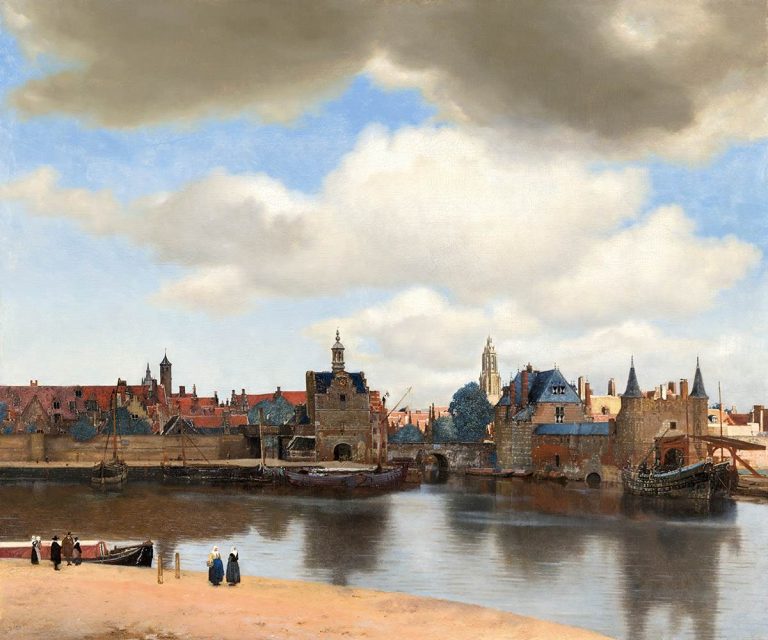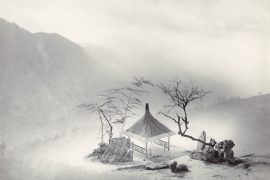After his death, his name was almost forgotten. For many years people thought his paintings were by other artists who were better known at the time, such as Pieter de Hooch (1629-1684). But Vermeer was ‘rediscovered’ in the 19th century. French art critic Théophile Thoré (1807-1869) called him a genius, and made sure he received lots of international attention, as he still does today.
Pieter de Hooch, A Man Smoking and a Woman Drinking in a Courtyard, c. 1658 – 1660
Thoré the art critic called him ‘The Sphinx of Delft’, because so little was known about him in the 19th century. He is still a mysterious figure in art history, and researchers are still very interested in the way he worked. He deliberately left out some details you would expect to see. His outlines were sketchy and he used lots and lots of tiny dots of paint to suggest the reflection of light.
Because of this unusual painting technique, experts wonder whether he might have used special equipment like a ‘camera obscura’ – a box in which you could project an image of the outside world. But would an artist who was so good at painting perspective and light even need such equipment?
Famous for his intimate household scenes with amazing light, Johannes Vermeer is one of the most famous Dutch painters of the 17th century. In other paintings by Vermeer, such as the famous Girl with a Pearl Earring and View of Delft, he managed to create a calm, almost timeless atmosphere.
Vermeer always spent a long time on every painting, so he did not complete many pictures. We know of only 36 paintings by him. Vermeer was also an art dealer and valuer.
Johannes Vermeer, Diana and Her Companions, c. 1653 – 1654
Vermeer lived and worked in Delft all his life. He might have been trained by fellow Delft artist Carel Fabritius (1622-1654) or by Leonaert Bramer (1596-1674). Vermeer was a Protestant, but in 1653 he married a rich Catholic woman, Catharina Bolnes, and they had fourteen children. The whole family lived with Catharina’s mother, Maria Thins.
History paintings
Vermeer started working as a painter around 1654. His earliest works were history paintings, pictures of scenes from the Bible and from mythology. They were inspired by painters from Amsterdam and Utrecht. Vermeer’s mother-in-law had work by them in her small art collection, so he could see them every day.
It took a lot of knowledge and thought to make history paintings. They were therefore seen as more impressive than landscapes, portraits and still lifes, which only imitated real life.
Johannes Vermeer, The Milkmaid, ca. 1660, Rijksmuseum, Amsterdam
Vermeer liked calm, relaxed scenes. Time seems to stand still for a moment in his compositions. The characters in his paintings are often deep in thought. Vermeer’s early history paintings are different from his later paintings. They are large, with strong light and shade contrasts, and the characters fill the image. But the calm, intimate atmosphere that Vermeer is famous for is also there in his earliest work.
Household scenes
Vermeer started painting his famous household scenes around 1656, possibly under the influence of Pieter de Hooch. In these paintings, one or more figures – usually women – are shown doing ordinary things like pouring milk, making lace, playing music or reading a letter. Vermeer was careful to paint everything as precisely as possible. Even the parts of the painting in the shade include every little detail, which would have taken a lot of time. These are things you only see if you look at the paintings for a long time.
One very obvious thing about these paintings is the light coming in through a window. Vermeer also used lots of dots of paint to give the appearance of light being reflected by pottery, satin or water.
Johannes Vermeer, Girl with a Pearl Earring, c. 1665
Pearl And Ultramarine
Girl with a Pearl Earring is Vermeer’s most famous painting. It is not a portrait, but a ‘tronie’ – a painting of an imaginary figure. Tronies depict a certain type or character; in this case a girl in exotic dress, wearing an oriental turban and an improbably large pearl in her ear.
Johannes Vermeer was the master of light. This is shown here in the softness of the girl’s face and the glimmers of light on her moist lips. And of course, the shining pearl.
Pearls – real or imitation – were very fashionable in Vermeer’s day. You can see them in many paintings from that time. But there is no other 17th-century Dutch painter who is so well known for painting pearls as Vermeer. They appear in 18 of his 36 paintings. He was also incredibly good at painting pearls, using only a few, perfectly placed strokes of his brush.
The blue in Vermeer’s paintings is very intense. He used a special pigment, ultramarine, for the colour. It was made of a bright blue mineral called lazurite from the semi-precious stone lapis lazuli, which came from Afghanistan.
Ultramarine was very rare, so it was the most expensive pigment you could buy at that time. It was even more expensive than gold. How Vermeer could afford it is a mystery, but he used lots of ultramarine in his paintings, not only in clothes, but also in parts that were not so noticeable, like in the shadows.
Johannes Vermeer, View of Delft, c. 1660 – 1661
Famous artist
Vermeer lived in Delft his whole life, and was famous in the town. The Delft painters’ guild chose him as its leader twice. The only surviving panoramic view of Delft is by Vermeer. Rich art collector Pieter Claesz van Ruijven of Delft loved Vermeer’s work, and was one of his biggest customers. He owned about half of the paintings Vermeer ever produced.
This is the most famous cityscape of the Dutch seventeenth century. We are looking at Delft from the south. There is hardly a breath of wind and the city has an air of tranquillity. Vermeer reflected this tranquillity in his composition, by making three horizontal strips: water, city and sky.
He also painted the buildings a bit neater than they actually were. The interplay of light and shade, the impressive cloudy sky and the subtle reflections in the water make this painting an absolute masterpiece.
Via Mauritshuis












